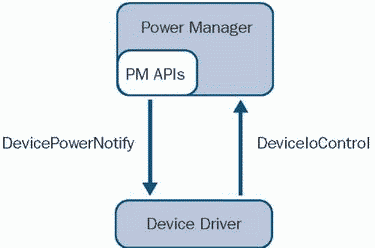Книга: Microsoft Windows Embedded CE 6.0 Exam Preparation Kit
Device Driver Interface
Device Driver Interface
In order to integrate with the Power Manager, device drivers must support a set of I/O controls (IOCTLs). Power Manager uses these to query device-specific power capabilities as well as to set and change the device's power state, as illustrated in Figure 3-10. Based on the Power Manager IOCTLs, the device driver should put the hardware device into a corresponding power configuration.

Figure 3-10 Power Manager and device driver interaction
Power Manager uses the following IOCTLs to interact with device drivers:
? IOCTL_POWER_CAPABILITIES Power Manager checks the power management capabilities of the device driver. The returned information should reflect the capabilities of the hardware and the driver managing the hardware device. The driver must return only supported Dx states.
? IOCTL_POWER_SET Power Manager forces the driver to switch to a specified Dx state. The driver must perform the power transition.
? IOCTL_POWER_QUERY Power Manger checks to see if the driver is able to change the state of the device.
? IOCTL_POWER_GET Power Manager wants to determine the current power state of the device.
? IOCTL_REGISTER_POWER_RELATIONSHIP Power Manager notifies a parent driver to register all child devices that it controls. Power Manager sends this IOCTL only to devices that include the POWER_CAP_PARENT flag in the Flags member of the POWER_CAPABILITIES structure.
NOTE
Internal power state transitions
To ensure reliable power management, device drivers should not change their own internal power state without the involvement of Power Manager. If a driver requires a power state transition, the driver should use the DevicePowerNotify function to request the power state change. The driver can then change its internal power state when Power Manager sends a power state change request back to the driver.
- Creating and Deleting Device Objects
- 10.3.4. Flash Chip Drivers
- 1.3.11 LCD Drivers
- A Tour of Linux Network Devices
- The PLIP Driver
- Chapter 15 WdmIo and PHDIo Drivers
- Device Names
- USB Client Driver Design
- Power Manager Device Drivers Interface
- JDBC Туре 4 DRIVER
- Chapter 15. Graphical User Interfaces for Iptables
- Displaying Interface Statistics




